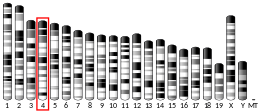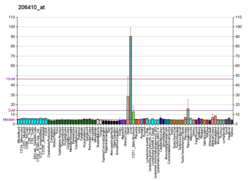NR0B2
گیرندهٔ هستهای، زیرخانوادهٔ صفر، گروه بی، عضو ۲ (انگلیسی: Nuclear receptor subfamily 0, group B) که با نام «شریک کوچک هترودایمر» (SHP) هم شناخته میشود، یک پروتئین است که در انسان توسط ژن «NR0B2» کُدگذاری میشود.[۴]
این پروتئین عضوی از خانوادهٔ گیرندههای فاکتور رونویسی درونهستهای است.[۵] آنچه دربارهٔ این پروتئین غیرعادی است، این است که فاقد دومِـین متصلشونده به دیانای است. بدین ترتیب بهلحاظ فنی، نه فاکتور رونویسی محسوب میشود و نه گیرنده هستهای؛ اما چون توالیهای همساختشناسی زیادی با سایر اعضای خانوادهٔ گیرندههای هستهای دارد، آنرا نیز نوعی گیرنده هستهای در نظر میگیرند.
اهمیت بالینی
[ویرایش]نقش اصلی SHP سرکوب سایر گیرندههای هستهای از طریق تولید یک هترودایمر غیرسازنده است.[۶] این پروتئین یک عامل میانجی در ساعت بیولوژیک متابولیسم بدن است.[۷] پژوهشها نشان دادهاست که این پروتئین با گیرنده هورمون تیروئید، گیرنده رتینوئید و گیرنده استروژن تعامل دارد و آنها را مهار میکند.
تعامل مولکولی
[ویرایش]این مولکول با پروتئینهای زیر تعامل پروتئین-پروتئین دارد:
منابع
[ویرایش]- ↑ ۱٫۰ ۱٫۱ ۱٫۲ GRCm38: Ensembl release 89: ENSMUSG00000037583 - Ensembl, May 2017
- ↑ "Human PubMed Reference:". National Center for Biotechnology Information, U.S. National Library of Medicine.
- ↑ "Mouse PubMed Reference:". National Center for Biotechnology Information, U.S. National Library of Medicine.
- ↑ "Entrez Gene: NR0B2 nuclear receptor subfamily 0, group B, member 2".
- ↑ Lee HK, Lee YK, Park SH, Kim YS, Park SH, Lee JW, et al. (June 1998). "Structure and expression of the orphan nuclear receptor SHP gene". The Journal of Biological Chemistry. 273 (23): 14398–402. doi:10.1074/jbc.273.23.14398. PMID 9603951.
- ↑ Båvner A, Sanyal S, Gustafsson JA, Treuter E (December 2005). "Transcriptional corepression by SHP: molecular mechanisms and physiological consequences". Trends in Endocrinology and Metabolism. 16 (10): 478–88. doi:10.1016/j.tem.2005.10.005. PMID 16275121.
- ↑ Wu N, Kim KH, Zhou Y, Lee JM, Kettner NM, Mamrosh JL, et al. (September 2016). "Small Heterodimer Partner (NR0B2) Coordinates Nutrient Signaling and the Circadian Clock in Mice". Molecular Endocrinology. 30 (9): 988–95. doi:10.1210/me.2015-1295. PMC 5004116. PMID 27427832.
- ↑ Gobinet J, Auzou G, Nicolas JC, Sultan C, Jalaguier S (December 2001). "Characterization of the interaction between androgen receptor and a new transcriptional inhibitor, SHP". Biochemistry. 40 (50): 15369–77. doi:10.1021/bi011384o. PMID 11735420.
- ↑ Seol W, Choi HS, Moore DD (May 1996). "An orphan nuclear hormone receptor that lacks a DNA binding domain and heterodimerizes with other receptors". Science. 272 (5266): 1336–9. doi:10.1126/science.272.5266.1336. PMID 8650544.
- ↑ Seol W, Hanstein B, Brown M, Moore DD (October 1998). "Inhibition of estrogen receptor action by the orphan receptor SHP (short heterodimer partner)". Molecular Endocrinology. 12 (10): 1551–7. doi:10.1210/me.12.10.1551. PMID 9773978.
- مشارکتکنندگان ویکیپدیا. «Small heterodimer partner». در دانشنامهٔ ویکیپدیای انگلیسی، بازبینیشده در ۱۶ مارس ۲۰۲۰.
برای مطالعهٔ بیشتر
[ویرایش]- Seol W, Choi HS, Moore DD (May 1996). "An orphan nuclear hormone receptor that lacks a DNA binding domain and heterodimerizes with other receptors". Science. 272 (5266): 1336–9. doi:10.1126/science.272.5266.1336. PMID 8650544.
- Seol W, Hanstein B, Brown M, Moore DD (October 1998). "Inhibition of estrogen receptor action by the orphan receptor SHP (short heterodimer partner)". Molecular Endocrinology. 12 (10): 1551–7. doi:10.1210/me.12.10.1551. PMID 9773978.
- Lee YK, Dell H, Dowhan DH, Hadzopoulou-Cladaras M, Moore DD (January 2000). "The orphan nuclear receptor SHP inhibits hepatocyte nuclear factor 4 and retinoid X receptor transactivation: two mechanisms for repression". Molecular and Cellular Biology. 20 (1): 187–95. doi:10.1128/MCB.20.1.187-195.2000. PMC 85074. PMID 10594021.
- Johansson L, Båvner A, Thomsen JS, Färnegårdh M, Gustafsson JA, Treuter E (February 2000). "The orphan nuclear receptor SHP utilizes conserved LXXLL-related motifs for interactions with ligand-activated estrogen receptors". Molecular and Cellular Biology. 20 (4): 1124–33. doi:10.1128/MCB.20.4.1124-1133.2000. PMC 85230. PMID 10648597.
- Lu TT, Makishima M, Repa JJ, Schoonjans K, Kerr TA, Auwerx J, Mangelsdorf DJ (September 2000). "Molecular basis for feedback regulation of bile acid synthesis by nuclear receptors". Molecular Cell. 6 (3): 507–15. doi:10.1016/S1097-2765(00)00050-2. PMID 11030331.
- Nishigori H, Tomura H, Tonooka N, Kanamori M, Yamada S, Sho K, et al. (January 2001). "Mutations in the small heterodimer partner gene are associated with mild obesity in Japanese subjects". Proceedings of the National Academy of Sciences of the United States of America. 98 (2): 575–80. doi:10.1073/pnas.021544398. PMC 14629. PMID 11136233.
- Lee YK, Moore DD (January 2002). "Dual mechanisms for repression of the monomeric orphan receptor liver receptor homologous protein-1 by the orphan small heterodimer partner". The Journal of Biological Chemistry. 277 (4): 2463–7. doi:10.1074/jbc.M105161200. PMID 11668176.
- Nishizawa H, Yamagata K, Shimomura I, Takahashi M, Kuriyama H, Kishida K, et al. (January 2002). "Small heterodimer partner, an orphan nuclear receptor, augments peroxisome proliferator-activated receptor gamma transactivation". The Journal of Biological Chemistry. 277 (2): 1586–92. doi:10.1074/jbc.M104301200. PMID 11696534.
- Sanyal S, Kim JY, Kim HJ, Takeda J, Lee YK, Moore DD, Choi HS (January 2002). "Differential regulation of the orphan nuclear receptor small heterodimer partner (SHP) gene promoter by orphan nuclear receptor ERR isoforms". The Journal of Biological Chemistry. 277 (3): 1739–48. doi:10.1074/jbc.M106140200. PMID 11705994.
- Gobinet J, Auzou G, Nicolas JC, Sultan C, Jalaguier S (December 2001). "Characterization of the interaction between androgen receptor and a new transcriptional inhibitor, SHP". Biochemistry. 40 (50): 15369–77. doi:10.1021/bi011384o. PMID 11735420.
- Klinge CM, Jernigan SC, Risinger KE (March 2002). "The agonist activity of tamoxifen is inhibited by the short heterodimer partner orphan nuclear receptor in human endometrial cancer cells". Endocrinology. 143 (3): 853–67. doi:10.1210/en.143.3.853. PMID 11861507.
- Ogata M, Awaji T, Iwasaki N, Miyazaki S, Bell GI, Iwamoto Y (March 2002). "Nuclear translocation of SHP and visualization of interaction with HNF-4alpha in living cells". Biochemical and Biophysical Research Communications. 292 (1): 8–12. doi:10.1006/bbrc.2002.6593. PMID 11890664.
- Cao H, Hegele RA (2002). "Identification of polymorphisms in the human SHP1 gene". Journal of Human Genetics. 47 (8): 445–7. doi:10.1007/s100380200062. PMID 12181644.
- Brendel C, Schoonjans K, Botrugno OA, Treuter E, Auwerx J (September 2002). "The small heterodimer partner interacts with the liver X receptor alpha and represses its transcriptional activity". Molecular Endocrinology. 16 (9): 2065–76. doi:10.1210/me.2001-0194. PMID 12198243.
- Borgius LJ, Steffensen KR, Gustafsson JA, Treuter E (December 2002). "Glucocorticoid signaling is perturbed by the atypical orphan receptor and corepressor SHP". The Journal of Biological Chemistry. 277 (51): 49761–6. doi:10.1074/jbc.M205641200. PMID 12324453.
- Hung CC, Farooqi IS, Ong K, Luan J, Keogh JM, Pembrey M, et al. (May 2003). "Contribution of variants in the small heterodimer partner gene to birthweight, adiposity, and insulin levels: mutational analysis and association studies in multiple populations". Diabetes. 52 (5): 1288–91. doi:10.2337/diabetes.52.5.1288. PMID 12716767.
- Lai K, Harnish DC, Evans MJ (September 2003). "Estrogen receptor alpha regulates expression of the orphan receptor small heterodimer partner". The Journal of Biological Chemistry. 278 (38): 36418–29. doi:10.1074/jbc.M303913200. PMID 12842887.
- Kovacic A, Speed CJ, Simpson ER, Clyne CD (January 2004). "Inhibition of aromatase transcription via promoter II by short heterodimer partner in human preadipocytes". Molecular Endocrinology. 18 (1): 252–9. doi:10.1210/me.2003-0211. PMID 14593077.
پیوند به بیرون
[ویرایش]- small heterodimer partner protein در سرعنوانهای موضوعی پزشکی (MeSH) در کتابخانهٔ ملی پزشکی ایالات متحدهٔ آمریکا



